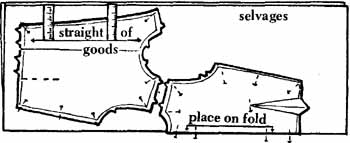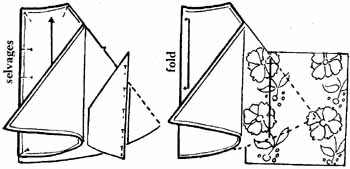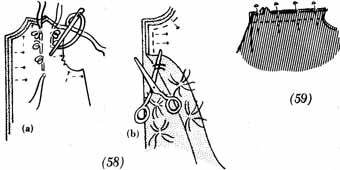As you read over the work procedure you may think it takes a long time before you start to stitch your garment. That is one reason why beginners should choose a simple garment.
Follow the order for every garment. Check off the points as you do them. After making a number of garments you will remember the order and will work more quickly. Some parts can be done ahead of time and speed up the procedure; such as:
- straightening crosswise ends, testing for shrinkage and shrinking if necessary.
- trimming pattern pieces to be used; learning the name of the piece and reading the printing on each piece.
- marking the crosswise grainline on each pattern piece — at bust level — front and back; at hip level — front and back.
- observing which pieces: will be placed on the fold; cut singly; cut two; to be faced; to be interfaced.
- marking the cutting layout on the sewing guide.
- reading the sewing guide carefully; visualizing the processes of construction.
GENERAL ORDER of WORK
1. On sewing guide — circle correct layout view for the width of your fabric and size.
2. Select pattern pieces to be used for your view and trim them.
3. Measurement chart -- Then, enter measurements necessary for the garment. Note all alterations necessary.
4. Alter pattern where necessary. Increases that will be made at the seam allowance edges and at lower edges can be drawn on the fabric. Using a colored pencil, write the amount of increase on that seam allowance or lower edge on the paper pattern.
5. Straighten the fabric, shrink fabric, stretch.
6. Fold fabric according to layout to be used.
7. Pin edges of fabric together; across ends; down sides.
8. Place pattern, tentatively, on fabric; correct pattern pieces at folded edge.
9. Pin fabric to pattern, following the correct procedure. (Read the instructions for pinning, piecing, cutting, and transferring pattern markings, which follow immediately after this order of work.)
10. Check all grainlines again — the fit of the garment depends on the grainline.
11. Cut — follow instructions for cutting.
12. Transfer pattern markings to fabric — follow instructions.
13. Mark center front and center back with a row of basting. (If there is a center front or center back seam it will serve the purpose.)
14. Mark the crossline grainlines, which you drew on your pattern pieces, with tailor tacks.
15. Mark all other necessary points.
16. Re-read the sewing guide, looking at each section of the garment as you read about it.
17. Do not remove the pattern from the garment piece until you are ready to use it. When you remove the pattern, mark the wrong side of the fabric with chalk; label each section with chalk or magic tape.
18. Indicate on each garment piece, especially on four-piece skirt sections, which seam is a side seam and which is a center seam, to avoid con fusion when joining the garment sections.
19. Make sample seams to determine tension and size of stitch: 1) on lengthwise grain, 2) on crosswise grain, 3) on bias grain.
20. Make a sample dart, if your garment has darts. Use a piece of fabric at least 2 inches longer than the finished dart.
21. Press all samples to determine: heat of iron required for fabric; whether or not fabric tends to shine; whether or not seam edges and darts will mark through on the right side.
22. Proceed to sew — do a minimum of basting; read instructions which follow this order of work regarding pin-basting, direction of stitching, stay stitching.
Note: This work procedure is for all garments. Omit any item which doesn't apply to the garment which you are constructing and proceed to the next item; e.g., “mark crosswise grain at hip level” — a blouse may not extend to hip level; bust level doesn't apply to skirts.

PINNING PATFERN to FABRIC
When pattern is placed with printed side up it's shown on the layout in white. When pattern is placed with printed side down, it's shaded.
- The selvage and the fold represent the lengthwise grainline. Place all the pattern pieces, tentatively, on the fabric according to the layout. On every piece, pin the grainline first, measuring accurately, so grainline is exactly on grainline of fabric and parallel to edge.

- Then pin along the seamline opposite grainline; keep pattern flat and smooth. Place pins inside the cutting line, at right angles to the cutting line. Why? Pins set at right angles will give a smoother cut edge. Continue pinning; place pins every 5 to 6 inches. Pin corners diagonally.
- Pin or plan for entire pattern before cutting.
- Check all grainlines again. Be sure all pieces on the fold are exactly on the fold.
- Did you use the required number of pieces? Did you draw the required alterations on the fabric accurately?

Layout for nap, pile, or one-way design
CUTTING
Use sharp shears of a size suitable for the weight of the fabric. Never use pinking shears.
- Cut with long, smooth strokes, moving the shears before they are quite closed. Why? If you close the shears at every stroke, you are apt to get a jagged edge which may interfere when machine stitching and trying to keep cut edge exactly on the guide line of the machine throat plate. Hold the fabric flat with the left hand. Use shorter strokes for cutting around curves. Do not shift the fabric — walk around the table instead.
- Cut exactly on the cutting line, so the fabric will be the same size as the paper pattern. Remember, inaccurate cutting results in a garment being larger than the measurements.
- Watch for all lines drawn on fabric for the increases.
- Cut all notches pointing out. Why? Seams will be stronger and could be let out if necessary.
- Sometimes pattern pieces are cut singly, e.g., sleeves. Take care that you don't cut both sleeves for the same armhole. Cut one sleeve first, place on the other piece of fabric, right sides of fabric together, and on the grainline; cut second sleeve.
- Styles with a side closing have separate pattern pieces for the right and for the left side of the garment. These are cut singly. Be sure the pattern is placed correctly on the fabric. Read the guide carefully. It states whether or not right side of fabric is up; it illustrates clearly whether or not to place pattern with printed side up or down. This method is observed for all pieces that are cut singly.
PIECING
Sometimes width of the fabric being used requires piecing in order to cut garment from a minimum of yardage.

(1) Plan so the piecing occurs in an inconspicuous place — near underarm seam of bodice or sleeve.
(2) Piece on lengthwise grain if possible, because a flatter seam is obtained.
(3) Pull thread or use selvage to establish lengthwise grain.
(4) Find a piece of cloth of same size and of correct grainline. Pull threads to establish grainline pieces to be joined unless there are selvages.
(5) Remember, you require a seam allowance; if fabric has a design, the designs must be matched. Lay piece to be joined beside garment and plan your join, considering seams and matching. A narrow seam is adequate.
(6) Unpin part of the pattern and fold out of the way.
(7) Pin, baste, machine stitch piece to garment. Press.
(8) Lay fabric flat on table; place folded pattern over joined section; pin; cut.
HINTS for CUTTING
- Cut across a series of notches instead of cutting each notch individually.
- Cut a small notch, at cut edge, to indicate center front and center back of the section.
- Cut a small notch on sleeve cap to indicate the point at which it matches the shoulder seam.
- Cut a small notch on neckline seam of collar to indicate center.

TRANSFERRING PATTERN MARKINGS to FABRIC
Carbon paper and tracing wheel — follow the instructions which ac company the carbon paper. Use either a smooth or toothed tracing wheel, depending on fabric.
- Test mark a scrap of fabric. Will it show through on the right side? Will marks disappear when washed or pressed?
- Be sure marks will be on wrong side of fabric.
- When marking two layers of fabric, with right sides together, insert one strip of carbon under the bottom layer and another strip under the pattern on the top layer of fabric carbon side of paper next to fabric.
- Make a test sample using two layers of fabric.
- Place garment section over a magazine to protect table.
- Use a ruler or yardstick to mark straight lines.
- Indicate point of darts with a short line across tip.
- Hold pattern against carbon and fabric to avoid slippage.
- Use carbon paper with discretion.
Tailor’s Tacks — Many dressmakers prefer tailor’s tacks to carbon because the thread markings are on both side of the fabric and no markings remain on the finished garment. Read section 3 regarding different types of thread and yarn to be used. Use different colors of thread to designate sections or points that will be joined together.
- Use a long, unknotted double thread. Place garment section on a flat surface. Insert the needle at right angles to the pattern and fabric. Why? A slant on the needle, especially in bulky fabric can result in inaccurate marking on the lower layer of fabric. Stand up, if necessary, when working. (See diagram 58 a and b.)
- Take a small stitch through pattern and fabric exactly in the center of all dots, leaving a thread end about one inch long. Take a second stitch over the first leaving a one inch loop; cut thread leaving a one inch end. Cut loops; remove pattern; separate layers of fabric carefully; clip the threads, leaving tufts of thread on each piece of fabric. It is advisable to not cut the loops or separate the layers of fabric until ready to use that section of the garment.
- When marking points, be sure the stitch is exactly at the point.
- When marking lines, place the entire stitch on the line because inaccurate marking will result in inaccurate stitching which will alter the size of the garment.
- Tailor tack all crosswise grainlines that you drew on the paper pattern.
Why? The grainline is needed later when determining the fit of the garment.
- Mark the lengthwise grainline on center front and center back folds with a row of basting thread slipped along the folded edge. It will be at right angles to the lengthwise grainline.
- Mark darts, tucks, position of buttons and buttonholes, fold lines, stitching lines to be used for top stitching, points of collars and cuffs, position of pockets, etc.
- Before removing pattern check carefully to be sure you have marked everything that will assist you to assemble the garment.
- It is advisable for beginners to mark curved seams.
ASSEMBLING the CARMENT
Stay-stitching — is done before you begin to assemble the garment. Use normal stitch length and place the row of stitching about 1/2 inch from the cut edge. Its purpose is to prevent certain edges from stretching by holding the grain in place.
Direction of stay-stitching — Always stitch with the grain, never against it. To determine the direction of the grain, run your fingers along the cut edge. If the thread ends feather out, you are going against the grain. In general, you stitch: skirt seams — hem to waistline; side bodice — armhole to waistline; shoulders — neck to shoulder point; neck — shoulder edge to center front, shoulder to center back. If you use matching thread it will not need to be removed except on sheer fabrics.
Pinning — When pinning garment sections together, hold the cut edges uppermost so you can see that the cut edges are even. Place pins on the stitching line, picking up only a few fabric threads. Why? The stitching line is the point at which the pieces are intended to fit together. If this habit is formed you will have little difficulty when joining seams having opposite curves, e.g., setting sleeves in armholes.
When pinning shoulder seams together, pin first one end, then the other, having edges exactly even at beginning and end of stitching line; pin notches, then pin in between, ease in any fullness.
Lay long seams on a flat surface, pin ends, match notches; don't work in the same direction but work back and forth; pat fullness flat to avoid shoving all the fullness to one end.
When machine stitching a pinned seam, stitch up to the pin, remove, and continue. Do not stitch over pins; you may dull or break the sewing machine needle if it strikes a pin.